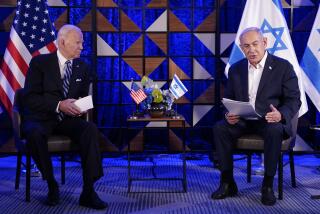Model for Free Trade
- Share via
The new free-trade agreement between Israel and the United States establishes an important model for freeing world trade while enhancing the competitive position of the United States.
This is the first time that the United States has established such an agreement. A decade of phased implementation has been proposed--a measure in itself of the difficulties involved, even among old friends. For Israel, it won’t make much difference right away; 85% of Israel’s exports to the U.S. market already are duty-free by American estimate, 95% by Israeli estimate. The larger effect will be in freeing access for American exports to Israel. At present, 18% of these exports are duty-free; that will rise to 52% immediately on implementation of the agreement
There is still some waffling in both Washington and Jerusalem on certain sensitive imports that could result in a less-than-total free-trade program, but both sides are confident that more than 99% of the trade between them will be duty-free by 1995.
In that same period, concessions between Israel and the European Economic Community also will be implemented. Without this new agreement, American exporters to Israel would find themselves at a distinct disadvantage.
Trade between the two nations is significant. Israel sold $1.45 billion in industrial exports to the American market last year. The United States sold $2 billion worth of industrial goods to Israel, not counting military equipment. These items represented about one-fourth of all of Israel’s exports and imports.
The technicalities that still must be resolved have to do with the timetable for extending duty concessions, step by step, until none are left. For the United States, for example, there remains sensitivity about imports from Israel of a half-dozen products, including textiles and processed foods. Israel is reluctant to drop all duty at this time on high-technology goods from the United States that would be directly competitive with newly established production in Israel. And Israel is concerned about American demands for an end to direct and indirect export subsidies.
There is recognition by both nations of the mutual advantage of the agreement in the long run, however. So the initialing Thursday is expected to set the stage for ratification by Congress and the Knesset before next year.
This same concept could well be applied to Canada, where much of the trade already is duty-free. The United States has said that it is ready to talk with anyone interested--a stance that is consistent with the Reagan Administration’s commitment to free trade. Congress has insisted in the 1984 trade act that each set of negotiations have congressional approval. That need not be a restraint.
More to Read
Sign up for Essential California
The most important California stories and recommendations in your inbox every morning.
You may occasionally receive promotional content from the Los Angeles Times.













